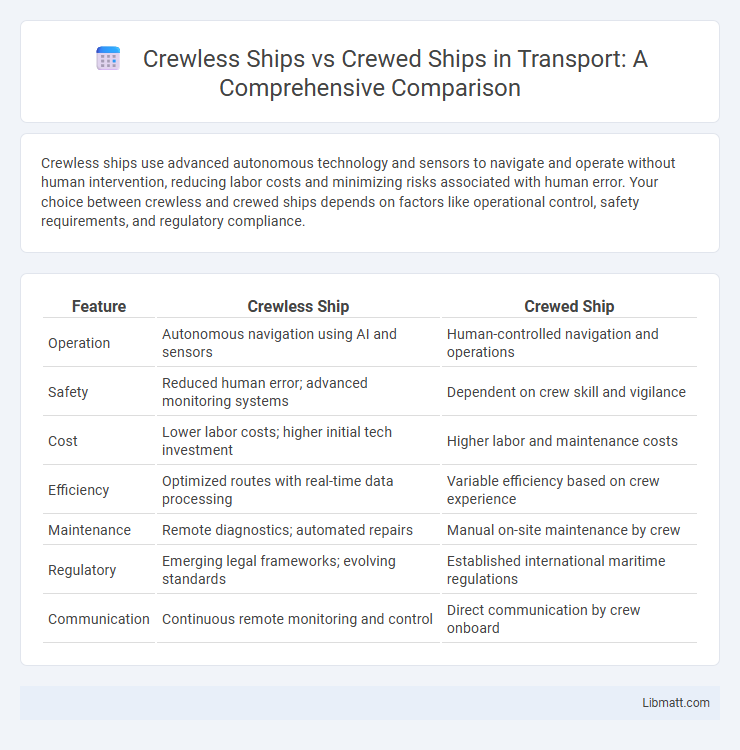Crewless ships use advanced autonomous technology and sensors to navigate and operate without human intervention, reducing labor costs and minimizing risks associated with human error. Your choice between crewless and crewed ships depends on factors like operational control, safety requirements, and regulatory compliance.
Table of Comparison
| Feature | Crewless Ship | Crewed Ship |
|---|---|---|
| Operation | Autonomous navigation using AI and sensors | Human-controlled navigation and operations |
| Safety | Reduced human error; advanced monitoring systems | Dependent on crew skill and vigilance |
| Cost | Lower labor costs; higher initial tech investment | Higher labor and maintenance costs |
| Efficiency | Optimized routes with real-time data processing | Variable efficiency based on crew experience |
| Maintenance | Remote diagnostics; automated repairs | Manual on-site maintenance by crew |
| Regulatory | Emerging legal frameworks; evolving standards | Established international maritime regulations |
| Communication | Continuous remote monitoring and control | Direct communication by crew onboard |
Introduction to Crewless and Crewed Ships
Crewless ships leverage advanced autonomous technologies, including AI navigation systems and remote monitoring, to operate without onboard human presence, enhancing efficiency and reducing operational costs. Crewed ships rely on skilled personnel to manage navigation, safety, and maintenance, ensuring real-time decision-making in complex maritime environments. Understanding the strengths of both allows you to evaluate their impact on shipping logistics and future maritime innovations.
Evolution of Maritime Technology
The evolution of maritime technology has rapidly advanced from traditional crewed ships to innovative crewless vessels equipped with autonomous navigation systems, real-time data analytics, and remote operation capabilities. These autonomous ships reduce human error, operational costs, and enhance safety by integrating AI-driven decision-making and advanced sensor networks. Your shipping operations can significantly benefit from this technological shift, improving efficiency and environmental sustainability in maritime transportation.
Key Differences: Crewless vs Crewed Ships
Crewless ships utilize advanced automation and AI technologies to operate without onboard personnel, significantly reducing human error and operational costs compared to traditional crewed ships. These autonomous vessels rely on remote monitoring and sophisticated sensors for navigation and safety, whereas crewed ships depend on human judgment for decision-making and emergency responses. Your choice between the two involves weighing the benefits of increased efficiency and lower labor expenses against the reliability and adaptability provided by experienced crew members.
Operational Efficiency and Performance
Crewless ships enhance operational efficiency by utilizing advanced AI for precise navigation, reducing human error, and enabling continuous operation without fatigue-related delays. Crewed ships rely on human decision-making and physical endurance, which can limit performance during long voyages or adverse conditions. Your fleet can achieve higher reliability and lower operational costs by integrating crewless technology, optimizing fuel consumption, and minimizing downtime.
Cost Comparison: Automation vs Human Crew
Crewless ships significantly reduce operational costs by eliminating expenses related to salaries, accommodations, and crew welfare, which typically account for up to 40% of a crewed ship's operating budget. Automation technology requires upfront investment in advanced navigation systems and AI, but long-term savings emerge from lower fuel consumption and reduced insurance premiums due to decreased human error. Your choice between a crewless or crewed vessel hinges on balancing initial capital outlay against ongoing labor and maintenance costs.
Safety, Reliability, and Risk Management
Crewless ships leverage advanced automation and real-time data analytics to enhance safety by minimizing human error and enabling precise navigation, while crewed ships depend heavily on human judgment and experience to manage onboard risks. Reliability in crewless vessels is bolstered by continuous system monitoring and predictive maintenance algorithms that reduce mechanical failures, whereas crewed ships can face variability due to fatigue and human factors. Your choice between crewless and crewed ships should consider how each approach manages operational risks and ensures consistent performance in diverse maritime conditions.
Environmental Impact and Sustainability
Crewless ships reduce environmental impact by optimizing fuel efficiency through AI-driven navigation and engine management, resulting in lower greenhouse gas emissions compared to crewed ships. These autonomous vessels enable continuous, precise monitoring of environmental conditions, minimizing oil spills and marine pollution risks. Sustainable shipping operations are enhanced by the reduced need for onboard resources such as food, water, and waste management, further decreasing the ecological footprint of maritime transport.
Legal and Regulatory Challenges
Crewless ships face significant legal and regulatory challenges due to the lack of established frameworks governing autonomous vessel operations, liability in accidents, and compliance with international maritime laws such as SOLAS and COLREGs. Crewed ships operate within clear legal guidelines and immediate human accountability, making regulatory enforcement more straightforward. Your understanding of these challenges is crucial for navigating the future integration of autonomous vessels into global shipping networks.
Future Trends in Maritime Shipping
Crewless ships are rapidly advancing with AI-driven navigation, reducing human error and operational costs, which is transforming future maritime shipping by enhancing efficiency and safety. Crewed ships continue to evolve with improved automation and hybrid systems, balancing human oversight with technological integration to address complex maritime challenges. The future trend in maritime shipping indicates a gradual shift towards autonomous vessels, supported by regulatory frameworks and technological innovation, reshaping global logistics and trade dynamics.
Conclusion: The Future of Shipping Industry
Crewless ships leverage advanced automation and AI technology to enhance operational efficiency, reduce human error, and lower costs compared to traditional crewed vessels. The shipping industry is rapidly adopting autonomous vessels to improve safety and environmental performance while addressing labor shortages and regulatory challenges. Your investment in this transformative technology positions your operations at the forefront of the evolving maritime landscape.
crewless ship vs crewed ship Infographic

 libmatt.com
libmatt.com